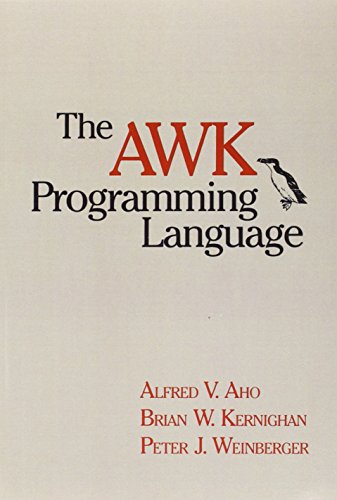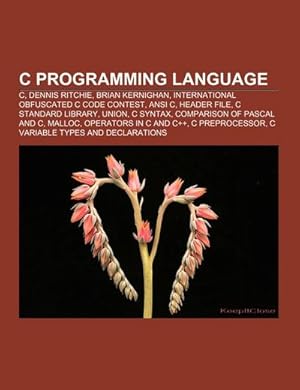programming language brian kernighan (2 resultados)
Filtros de búsqueda
Tipo de artículo
- Todos los tipos de productos
- Libros (2)
- Revistas y publicaciones (No hay ningún otro resultado que coincida con este filtro.)
- Cómics (No hay ningún otro resultado que coincida con este filtro.)
- Partituras (No hay ningún otro resultado que coincida con este filtro.)
- Arte, grabados y pósters (No hay ningún otro resultado que coincida con este filtro.)
- Fotografías (No hay ningún otro resultado que coincida con este filtro.)
- Mapas (No hay ningún otro resultado que coincida con este filtro.)
- Manuscritos y coleccionismo de papel (No hay ningún otro resultado que coincida con este filtro.)
Condición Más información
- Nuevo (2)
- Como nuevo, Excelente o Muy bueno (No hay ningún otro resultado que coincida con este filtro.)
- Bueno o Aceptable (No hay ningún otro resultado que coincida con este filtro.)
- Regular o Pobre (No hay ningún otro resultado que coincida con este filtro.)
- Tal como se indica (No hay ningún otro resultado que coincida con este filtro.)
Encuadernación
- Todas
- Tapa dura (No hay ningún otro resultado que coincida con este filtro.)
- Tapa blanda (2)
Más atributos
- Primera edición (No hay ningún otro resultado que coincida con este filtro.)
- Firmado (No hay ningún otro resultado que coincida con este filtro.)
- Sobrecubierta (No hay ningún otro resultado que coincida con este filtro.)
- Con imágenes (1)
- No impresión bajo demanda (1)
Idioma (2)
Precio
- Cualquier precio
- Menos de EUR 20 (No hay ningún otro resultado que coincida con este filtro.)
- EUR 20 a EUR 45
- Más de EUR 45
Gastos de envío gratis
Ubicación del vendedor
Valoración de los vendedores
-
The AWK Programming Language Aho, Alfred V.; Kernighan, Brian W. and Weinberger, Peter J.
Librería: DeckleEdge LLC, Albuquerque, NM, Estados Unidos de America
EUR 84,46
Convertir monedaGratis gastos de envío en Estados Unidos de AmericaCantidad disponible: 1 disponibles
Añadir al carritoCondición: New.
-
C programming language : C, Dennis Ritchie, Brian Kernighan, International Obfuscated C Code Contest, ANSI C, Header file, C standard library, Union, C syntax, Comparison of Pascal and C, Malloc, Operators in C and C++, C preprocessor
Publicado por Books LLC, Reference Series
ISBN 10: 1157061346 ISBN 13: 9781157061342
Librería: AHA-BUCH GmbH, Einbeck, Alemania
EUR 27,97
Convertir monedaEUR 61,14 gastos de envío desde Alemania a Estados Unidos de AmericaCantidad disponible: 1 disponibles
Añadir al carritoTaschenbuch. Condición: Neu. nach der Bestellung gedruckt Neuware - Printed after ordering - Source: Wikipedia. Pages: 107. Chapters: C, Dennis Ritchie, Brian Kernighan, International Obfuscated C Code Contest, ANSI C, Header file, C standard library, Union, C syntax, Comparison of Pascal and C, Malloc, Operators in C and C++, C preprocessor, C variable types and declarations, Compatibility of C and C++, Standard streams, Atan2, Sizeof, C string, C99, Typedef, Setcontext, Volatile variable, Duff's device, The C Programming Language, Struct, Precompiled header, Wide character, C1X, Undefined behavior, List of C functions, Strlcpy, Intel Memory Model, Sequence point, Digraphs and trigraphs, Impulse C, Interactive C, Blocks, Include guard, MISRA C, Ldexp, Pragma once, Long double, The lexer hack, Function prototype, ANSI/ISO C Specification Language, Offsetof, Variadic macro, Underhanded C Contest, Restrict, Strtod, Comma operator, Atoi, Size t, Strtol, F2c, Signature, Header-only, Prefix header, C Traps and Pitfalls, PhysicsFS, CFLAGS, Clone, Fputs, Swab, Translation unit, Pro C, Storage classes in C, Painted blue, BCX, Source Annotation Language, Remove, C for Dummies, LDAP Application Program Interface, Ltoa, C Primer Plus, Sigprocmask. Excerpt: The syntax of the C programming language is a set of rules that specifies whether the sequence of characters in a file is conforming C source code. The rules specify how the character sequences are to be chunked into tokens (the lexical grammar), the permissible sequences of these tokens and some of the meaning to be attributed to these permissible token sequences (additional meaning is assigned by the semantics of the language). C syntax makes use of the maximal munch principle. The C language represents numbers in three forms: integral, real and complex. This distinction reflects similar distinctions in the instruction set architecture of most central processing units. Integral data types store numbers in the set of integers, while real and complex numbers represent numbers (or pair of numbers) in the set of real numbers in floating point form. All C integer types have and variants. If or is not specified explicitly, in most circumstances is assumed. However, for historic reasons plain is a type distinct from both and . It may be a signed type or an unsigned type, depending on the compiler and the character set (C guarantees that members of the C basic character set have positive values). Also, bit field types specified as plain may be signed or unsigned, depending on the compiler. C's integer types come in different fixed sizes, capable of representing various ranges of numbers. The type occupies exactly one 'byte' (the smallest addressable storage unit), which is typically 8 bits wide. (Although can represent any of C's 'basic' characters, a wider type may be required for international character sets.) Most integer types have both and varieties; signed integer types may use a two's complement, ones' complement, or sign-and-magnitude representation. In many cases, there are multiple equivalent ways to designate the type; for example, and are synonymous. The representation of some types may include unused 'padding' bits, which occupy storage but are not included i.



